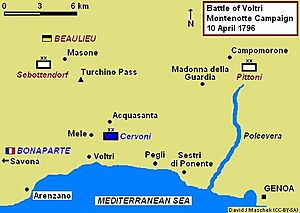Battle of Voltri facts for kids
Quick facts for kids Battle of Voltri |
|||||||
|---|---|---|---|---|---|---|---|
| Part of the French Revolutionary War | |||||||
|
|||||||
| Belligerents | |||||||
| Commanders and leaders | |||||||
| Strength | |||||||
| 5,200 | 7,200 | ||||||
| Casualties and losses | |||||||
| 227 | 50 | ||||||
The Battle of Voltri happened on April 10, 1796. It was an early fight in the French Revolutionary Wars. The battle took place in Voltri, a town near Genoa, Italy.
In this battle, two Austrian army groups attacked a French force. The Austrians were led by Johann Peter Beaulieu. The French were led by Jean-Baptiste Cervoni. After a few hours of fighting, the Austrians made the French retreat. The French moved west along the coast to Savona. Today, Voltri is part of the big Italian port city of Genoa. This battle was the first action of the Montenotte Campaign. This campaign was part of the War of the First Coalition.
In the spring of 1796, Beaulieu became the new leader of the Austrian and Sardinian armies. They were fighting in northwest Italy. The French also got a new army leader. His name was Napoleon Bonaparte. He came from Paris to lead the French Army of Italy. Bonaparte quickly started planning an attack. But Beaulieu attacked first. He struck Cervoni's French troops, who were spread out too much. After this battle, Beaulieu's army was in a difficult spot. It was hard for him to help his right side. Napoleon saw this chance. He attacked the Austrian right side in the Battle of Montenotte on April 12.
Contents
Why Did the Battle of Voltri Happen?
New Commanders and Army Challenges
In March 1796, Johann Peter Beaulieu became the commander of the Austrian Army of Italy. He was 70 years old. But he was seen as energetic and a good choice. Beaulieu was also friends with Michelangelo Alessandro Colli-Marchi. Colli led the allied Sardinian army.
However, Beaulieu's government worried that Sardinia might make peace with France. They even thought Sardinia might switch sides. This made it hard for the two allies to work together. Also, their supply lines went in different directions. Beaulieu also had 1,500 cavalry soldiers from the Kingdom of Naples and Sicily. The Austrian soldiers had a tough winter. Many got sick. Beaulieu told his government that 927 soldiers died from sickness in February. Together, the allied armies had about 17,000 Sardinians and 32,000 Austrians.
How the Armies Were Spread Out
Beaulieu's army was split into two main parts. His right side was led by Eugène-Guillaume Argenteau. It had about 9,000 infantry soldiers. These troops were spread out over a large area. They were separated by bad roads. For example, some were near Sassello, others at Mioglia, and more in other towns.
The left side of Beaulieu's army was led by Karl Philipp Sebottendorf. This part had about 19,500 soldiers. But only half of them could fight in the field. The rest were guarding different places. Against these forces, the French Army of Italy had 63,000 men. Only 37,000 of them were ready to fight. Another 7,000 troops guarded the Col de Tende pass.
French Plans and Austrian Response
In March 1796, a French official named Antoine Christophe Saliceti tried to get money from the neutral Republic of Genoa. He failed. So, Saliceti decided to threaten Genoa to get the loan. The French army commander, Barthélemy Louis Joseph Schérer, agreed. He ordered 6,000 men to get ready to move. This was a risky plan. It would stretch the French army an extra 28 miles (45 km) east along the Italian Riviera.
On March 24, French General Jean Joseph Magdeleine Pijon marched from Savona towards Genoa. Three days later, Austrian General Philipp Pittoni von Dannenfeld told Beaulieu that the French had taken Voltri. Around this time, Napoleon Bonaparte took over from Schérer. Napoleon first wanted to pull back the exposed French troops. But then he decided to hold the position at Voltri.
Beaulieu was worried about the French move. To stop this threat, he ordered Pittoni to invade the Republic of Genoa. Pittoni was to cross the Bocchetta Pass. Pittoni ignored Genoa's protests. He took Novi Ligure and sent his men up the pass. Beaulieu went with this move. He noted the weather was very cold. Pittoni was sick but kept doing his duty. The French commander, Pijon, also got sick. General Jean-Baptiste Cervoni took over the Voltri force.
On April 8, Pittoni held the Bocchetta Pass. But he told Beaulieu it would take six hours to reach Josef Philipp Vukassovich's troops. Vukassovich also said he was cut off from other Austrian forces. This meant Beaulieu's army was not in a good position to attack.
How the Battle Unfolded
On the morning of April 10, Pittoni's group had about 3,350 infantry and 624 cavalry. Sebottendorf's group had 3,200 men. Beaulieu joined Sebottendorf's group. They were ordered to cross the Turchino Pass north of Voltri.
Cervoni's French defenders had about 2,000 soldiers. They also had 3,181 men from another unit. Three companies of grenadiers were led by Jean Lannes. The French army had recently changed its unit numbers.
On April 9, the French 75th Line unit fought skirmishes all day. Cervoni placed his troops from Pegli to Bric Ghigermasso. This was a high point that controlled the road from Turchino Pass. French outposts were in the mountains. Pittoni sent 250 volunteers to protect his right side. They moved through the Shrine of Nostra Signora della Guardia. Pittoni's main force marched later. They moved down to the coast and into the village of Sestri di Polente.
On the other side, Sebottendorf's group cleared a French outpost from Masone village. This was around 2:00 PM. Then they started crossing the Turchino Pass. Vukassovich led the column. He sent soldiers to attack the hamlet of Acquasanta. Lannes led the French defense in this area. He pulled back his troops slowly, with few losses.
Pittoni's group began pushing the French 75th Line near Pegli around 3:00 PM. They captured two hills near Pegli with a bayonet attack. The French 75th Line held out until about 6:00 PM. Then they pulled back to avoid being surrounded. Four French companies were briefly surrounded but managed to escape. By 7:00 PM, most of the 75th Line had escaped the Austrian chase. They fell back along the coast. In the area facing the Turchino Pass, the French defenders fell back to a fort at Mele around 5:00 PM. Cervoni left Mele when Vukassovich threatened to attack his left side.
What Happened After the Battle?
Pittoni took over Voltri that evening with three battalions and his cavalry. Beaulieu joined him around midnight. The Austrians captured two French officers and some soldiers in the town. They also found 200 sacks of flour. The Austrians likely lost no more than 50 soldiers. The French had about 250 casualties. The 75th Line reported one officer killed and seven wounded or missing. They also had 16 killed, 45 wounded, and 148 captured among their regular soldiers.
Historian David G. Chandler said that Cervoni made a "masterly retreat." He avoided being trapped by the Austrians. Another historian, Martin Boycott-Brown, said Beaulieu made a big mistake. He moved his left army wing over the Bocchetta Pass. This move put a mountain range between his left wing and Argenteau's right wing. This made Argenteau's troops vulnerable. Beaulieu should have used a different plan. On April 12, Bonaparte won a victory over Argenteau in the Battle of Montenotte. This battle created a gap between the Austrian and Sardinian armies.
More Battles to Learn About
- Montenotte Campaign
- Battle of Montenotte, April 12, 1796
- Battle of Millesimo, April 13, 1796
- Second Battle of Dego, April 14–15, 1796
- Battle of Ceva, April 16, 1796
- Battle of Mondovì, April 21, 1796
|




